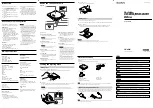
2
Operating instructions
Fail-safe delay timer
AZS 2305
EN
1.6 Warning about misuse
In case of improper use or manipulation of the safety switch-
gear, personal hazards or damages to machinery or plant
components cannot be excluded. The relevant requirements
of the standard ISO 14119 must be observed.
1.7 Exclusion of liability
We shall accept no liability for damages and malfunctions resulting from
defective mounting or failure to comply with this operating instructions
manual. The manufacturer shall accept no liability for damages
resulting from the use of unauthorised spare parts or accessories.
For safety reasons, invasive work on the device as well as arbitrary
repairs, conversions and modifications to the device are strictly
forbidden; the manufacturer shall accept no liability for damages
resulting from such invasive work, arbitrary repairs, conversions and/or
modifications to the device.
2. Product description
2.1 Ordering code
This operating instructions manual applies to the following types:
AZS 2305.
➀
No.
Option
Description
➀
24 VDC
1
110 VAC
2
230 VAC
Only if the information described in this operating instructions
manual are realised correctly, the safety function and therefore
the compliance with the Machinery Directive is maintained.
2.2 Special versions
For special versions, which are not listed in the order code below 2.1,
these specifications apply accordingly, provided that they correspond to
the standard version.
2.3 Purpose
The fail-safe delay timer is designed for control cabinet mounting. It is
used wherever a safe rating of a time "T" is required due to the inertial
movement of a machine or due to the operating time of the plant.
Design/operating principle
The fail-safe delay timer has a dual-channel structure. The time is
manually set in each channel by means of rotary and sliding switches
(refer to Setting the time "T"). It includes two safety relays with
monitored positive action contacts. The series-wired relay contacts
build the enabling paths.
The entire concept of the control system, in which the safety
component is integrated, must be validated to the relevant
standards.
2.4 Technical data
Standards:
IEC 60204-1; ISO 13849-1; IEC 61508
Enclosure:
glass-fibre reinforced thermoplastic
Mounting:
snaps onto standard DIN rail to EN 60715
Connection:
Screw connection: max. 2.5 mm²
(including conductor ferrules)
Protection class:
terminals IP20,
enclosure IP40
to IEC 60529
Start conditions:
Automatic
Rated operating voltage U
e
:
AZS 2305: 24 VDC ± 15%;
AZS 2305.1: 110 VAC ± 15%;
AZS 2305.2: 230 VAC ± 15%
Rated operating current:
0.1 A at 24 VDC
Power consumption:
< 5 W
Rated insulation voltage:
250 V
Rated impulse withstand voltage:
4 kV
Thermal test current I
the
:
6 A
Internal electronic fuse:
yes
Time range:
0.1 s … 99 min
t
min
:
0.1 s
t
max
:
99 min
Time tolerance:
< 2 %
Inputs monitoring:
S1 (S14), S1 (S22)
Cross-wire detection:
yes
Wire breakage detection:
yes
Earth connection detection:
yes
Input resistance:
approx. 2 kΩ against GND
Input signal "1":
10 … 30 VDC
Input signal "0":
0 … 2 VDC
Outputs:
- 13-14 / 23-24 / 33-34:
3 enabling paths each with
2 NO relay contacts in series
Utilisation category:
AC-15, DC-13
Rated operating voltage/current U
e
/I
e
:
2 A/250 VAC;2 A/24 VDC
Switching voltage:
max. 250 VAC
Load current:
max. 3 A (ohmic load)
Switching capacity:
max. 750 VA
Max. fuse rating:
6 A (quick blow) incoming
series connected
Additional outputs:
Y1, Y2, U
e
- 4 V; 100 mA,
short-circuit proof, p-type
Ambient temperature:
0 °C … +55 °C
Storage and transport temperature:
−25 °C … +70 °C
Max. cable length:
100 m of 0.75 mm² conductor
Max. switching frequency:
10 Hz
Resistance to vibration:
10 … 55 Hz;
amplitude 0.35 mm ±15%
at the control circuit
Resistance to shock:
30 g / 11 ms
EMC rating:
conforming to EMC Directive
2.5 Safety classification
Standards:
ISO 13849-1; IEC 61508
PL:
up to d
Control category:
up to 3
PFH value:
1.0 x 10
-7
/ h
SIL:
up to 2
Service life:
20 years
























